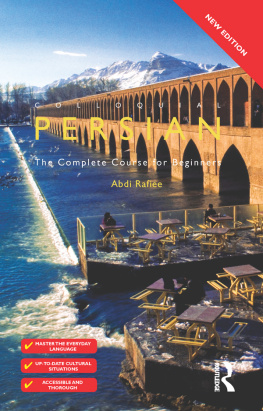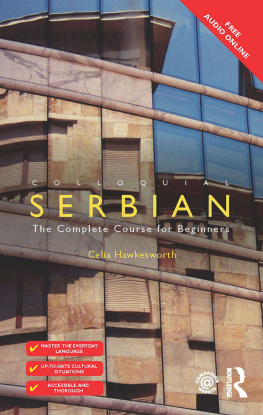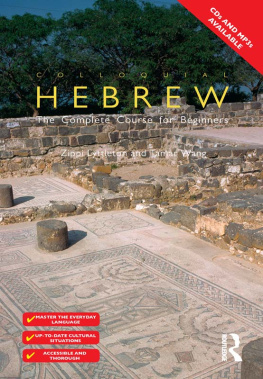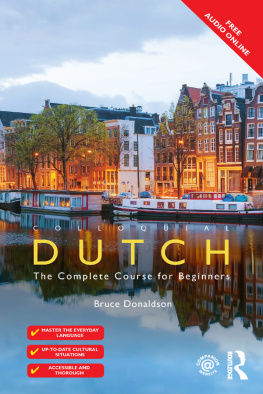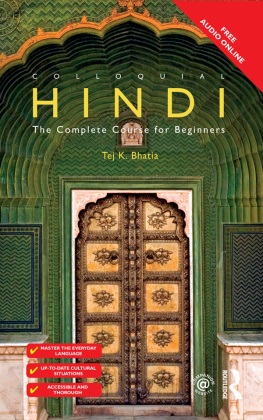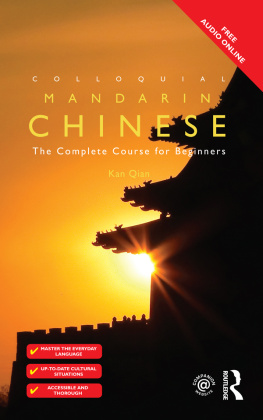Colloquial
Persian
THE COLLOQUIAL SERIESSeries Adviser: Gary King The following languages are available in the Colloquial series:
| Afrikaans | German | Romanian |
| Albanian | Greek | Russian |
| Amharic | Gujarati | Scottish Gaelic |
| Arabic (Levantine) | Hebrew | Serbian |
| Arabic of Egypt | Hindi | Slovak |
| Arabic of the Gulf | Hungarian | Slovene |
| Basque | Icelandic | Somali |
| Bengali | Indonesian | Spanish |
| Breton | Irish | Spanish of Latin America |
| Bulgarian | Italian | Swahili |
| Cambodian | Japanese | Swedish |
| Cantonese | Korean | Tamil |
| Catalan | Latvian | Thai |
| Chinese (Mandarin) | Lithuanian | Turkish |
| Croatian | Malay | Ukrainian |
| Czech | Mongolian | Urdu |
| Danish | Norwegian | Vietnamese |
| Dutch | Panjabi | Welsh |
| English | Persian | Yiddish (forthcoming) |
| Estonian | Polish | Yoruba |
| Finnish | Portuguese | Zulu (forthcoming) |
| French | Portuguese of Brazil |
COLLOQUIAL 2s series: The Next Step in Language Learning| Chinese | German | Russian |
| Dutch | Italian | Spanish |
| French | Portuguese of Brazil | Spanish of Latin America |
Colloquials are now supported by FREE AUDIO available online. All audio tracks referenced within the text are free to stream or download from www.routledge.com/cw/colloquials. If you experience any difficulties accessing the audio on the companion website, or still wish to purchase a CD, please contact our customer services team through www.routledge.com/info/contact. First edition published 1988
by Routledge
2 Park Square, Milton Park, Abingdon, Oxon OX14 4RN Second edition published 2001 This third edition published 2011 Simultaneously published in the USA and Canada
by Routledge
711 Third Avenue, New York, NY 10017
Routledge is an imprint of the Taylor & Francis Group, an informa business 1988 Leila Moshiri
2001, 2011 Abdi Rafiee The right of Abdi Rafiee to be identified as author of this work has been asserted by him in accordance with sections 77 and 78 of the Copyright, Designs and Patents Act 1988. Typeset in Avant Garde and Helvetica
by Graphicraft Limited, Hong Kong All rights reserved.
British Library Cataloguing in Publication Data A catalogue record for this book is available from the British Library
Library of Congress Cataloging in Publication Data Rafiee, Abdi, 1947 Colloquial Persian : the complete course for beginners / Abdi Rafiee.3rd ed.
p. cm. (The colloquial series
Includes bibliographical references and index. 1. 1.
Persian languageTextbooks for foreign speakersEnglish. 2. Persian languageGrammar. 3. Persian languageSpoken Persian. 4.
Persian languageSound recordings for English speakers. I. Title. PK6239.5.E5R34 2010 491.5582421dc22 2010006487 ISBN 13: 978-1-138-94977-5 (pbk)
Contents
Please email AcademiceBooksSupport@informa.com with proof of purchase to obtain access to the supplementary content for this eBook. An access code and instructions will be provided.
I would like to record my sincere gratitude to my sons, Hameed and Siam, for putting up with a part-time father while the second edition of this course was being prepared in the late 1990s, and for tolerating my part-time friendship since I was asked to produce the current edition.
I remain grateful to my wife, Sima, for filling the gap, as well as for reading the manuscript and making valuable suggestions. Since the publication of the second edition in 2001, I have received valuable feedback on the content and form of the course from my students as well as those from all over the world who have taken the trouble to write their views and comments about the course on the Internet. A big thank you to all of them. My thanks also go to the editorial team at Routledge for their comments and support. Abdi (Abdorreza) Rafiee
Congratulations on taking the first step towards learning the language of Hafez, Sadi, Ferdowsi and Khayyam, to name but a few of the literary giants Iran has proudly produced over the centuries as part of its contribution to the wealth of the worlds cultural heritage. On a practical level, I hope you will agree with the notion that a European learning another European language is one thing; a European learning a non-European language is quite another.
We cannot separate a language from the cultural factors (beliefs, assumptions, etc.) that have influenced and shaped it over the years. The cultural gap is significantly narrower and shallower between language communities within Europe than between Europe and the East. This means that a European attempting to learn an Eastern language will need to bridge a much wider and deeper cultural gap than if he or she were learning another European language. Despite the eastern cultural backdrop and using the Arabic alphabet, Persian is in fact an Indo-European language, i.e. related to English, and therefore much easier for English speakers to learn than Arabic. Indeed, some of my students have suggested that learning Persian first would make life much easier when you go on to learn Arabic.
In this course, I have tried to present a holistic picture of the Persian language, which includes not only the grammar of the word, the phrase and the sentence (i.e. the traditional view of grammar) but also the grammar of what to say to whom and how to say or not to say it (i.e. the grammar of communication). So, we will be concerned not just with grammatical accuracy, but also with the social and cultural appropriateness of what we say in Persian. Learning a foreign language without bothering about the (often) culture-specific norms governing the use of that language would be like learning how to drive a car without bothering about the Highway Code! Who is the course intended for? This course is intended for two types of learner: Those who wish to learn to speak, read and write in Persian. Those who wish to be able to communicate in Persian, without learning the script.
Type of Persian used The type of Persian used in this course is educated colloquial Tehrani, which is understood throughout Iran, thanks to the media. Although the principal objective of this course is to introduce spoken colloquial Persian, sufficient guidance is given for those who wish to go on to study literary Persian. The table on shows the varieties of language referred to in the book. Use of jargon I have tried to keep grammatical jargon to a minimum. Where a technical word is used, it is often backed up by a clarifying example. For instance, under Demonstratives, you are told: How to say this/these; that/those.
Layout of the book The book is divided into two parts. The first part introduces the Persian sound system and the script supported by a comprehensive exercise at the end. The second part comprises seventeen units. Each unit contains two dialogues in which everyday language is introduced in its appropriate social and cultural setting. Each dialogue is supported by Vocabulary, Language and culture notes and Exercises.
| Register | Style | Context | Example |
| Colloquial (spoken/written) | Formal | Addressing older people, or among participants in business meetings, using  |

